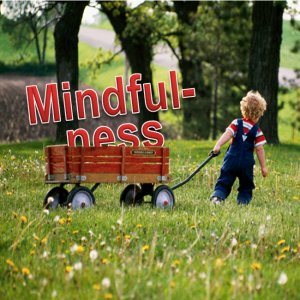I’d like to share some ideas around bringing mindfulness to bear in civil discourse. I view mindfulness from a personal, philosophical (and physiological) point of view rather than within the context of an Eastern Religion. Much of it springs from eastern philosophy and a way-of-being that is not necessarily bound to religion.
 Let me start by establishing a description of mindfulness so we can have a shared point of reference. The more common elements used to define mindfulness are:
Let me start by establishing a description of mindfulness so we can have a shared point of reference. The more common elements used to define mindfulness are:
- Noticing our thoughts and feelings without judging them.
- A focus on the present.
- A vehicle to calmly contemplate.
I once heard someone say “mindfulness is being aware of your thoughts without being jerked around by them.” I like that definition too.
As I’ve suggested in other posts (here and here), we have the ability to respond rather than react, to pause and return a considered opinion. If we practice mindfulness in general, we can become better at evaluating and less judgmental. We might be better at staying connected to now, and less likely to clutter our current dialog with encumbering tangents from our past.
So how might we do this? Two fundamental elements of mindfulness are:
- Calming yourself (often by focusing on breathing)
- Learning to be less attached to the things that pop into our heads.
And before I go any further, my disclaimer: I am no perfect practitioner of mindfulness (or of remaining calm, or postponing my quick rebuttals). It is, and I am (and forever will be) a work in progress.
One thing I have adopted, when engaged in heated or tough conversation with someone, is consciously pausing and taking one or more deliberate, long breaths. When I do, I am lowering my personal tension. I am inserting a pause. There are any number of studies that show the positive, physiological changes that follow such a simple thing. Your heart-rate may slow, your blood pressure may decrease, levels of chemicals negatively affecting your body and brain can ebb. Once in a better physical state, we have an opportunity to be in better emotional and cognitive states. When I do this, I am not just catching my breath, I am catching myself. And all this can begin to unfold as quickly as a few intentional breaths. If someone is feeling super tense, really agitated, or overwhelmed, it will take somewhat longer.
Responding
Once in that improved state, I can be less attached to my thoughts and less judgmental. I might now view several of my thoughts as options rather than having to choose one. I might realize my anger over something said is there, but not so energetic that it crowds out reason. There may be some thoughts or feelings, or past issues, I can let drift away. I can reduce, minimize, or discard my criticism of my feelings and thoughts. I can do the same for my assessment of the other(s) with whom I am engaged. In that improved physical state, after those few breaths, I can observe what I am experiencing, and evaluate, and then respond. Interestingly, doing this, can support and reinforce the calm that helped it unfold.
Lots of “ifs” and “mights”
 There were an abundance of qualified statements in the preceding paragraphs – indeed there were. These things can work and work sometimes better than others. It is a matter of degree, of situation and context, of repetition that reinforces the habits, of remembering to do it in peak moments. We sometimes chastise ourselves when we forget or do it poorly — which could hinder rather than help.
There were an abundance of qualified statements in the preceding paragraphs – indeed there were. These things can work and work sometimes better than others. It is a matter of degree, of situation and context, of repetition that reinforces the habits, of remembering to do it in peak moments. We sometimes chastise ourselves when we forget or do it poorly — which could hinder rather than help.
It can be done. It takes practice. That is a word you will hear often when dealing with mindfulness — practice. As we practice, and as we do better, these things get reinforced, more comfortable for us to do, are easier to remember – it gets wired into our brains.
Conclusion
Mindfulness is a very broad subject. I have only skimmed the topmost parts of it here. I am doing the fuller subject, which merits attention, a disservice by touching it so briefly and lightly. But, as with all my posts, I am trying to keep the content from running too long. I suspect I will do quite a few more posts on mindfulness and will refer to a lot of resources and links about it.
This brief treatment is meant to add another thread in a broader tapestry. Just as I will add threads from psychology about handling cognitive distortions and confirmation bias. These build around another recurring theme. These are things we can do, ourselves, to engage more effectively with others.
 If we bring mindfulness with us to civil discourse, we increase the odds of responding over reacting. We participate in a more civil way. We inspect our own thinking — not just that of the other guy or gal. They may find that valuable. We might decrease tension and forestall an escalation, as a calmer participant. We will have greater clarity for ourselves. All of these things are potential, positive contributions to civil discourse.
If we bring mindfulness with us to civil discourse, we increase the odds of responding over reacting. We participate in a more civil way. We inspect our own thinking — not just that of the other guy or gal. They may find that valuable. We might decrease tension and forestall an escalation, as a calmer participant. We will have greater clarity for ourselves. All of these things are potential, positive contributions to civil discourse.
